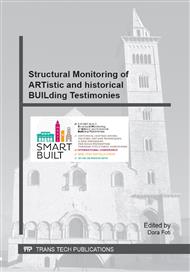[1]
Bankoff, G., Frerks, G. & Hilhorst, D. (Eds. ), Mapping vulnerability: disasters, development and people, London, Earthscan, (2004) 236.
Google Scholar
[2]
Birkmann, J. Measuring vulnerability to promote disaster-resilient societies: conceptual frameworks and definitions. IN Birkmann, J. (Ed. ) Measuring vulnerability to natural hazards: towards disaster resilient societies. Tokyo, United Nations University Press, (2006).
DOI: 10.1111/j.1539-6975.2010.01389.x
Google Scholar
[3]
Cutter, S. L., Vulnerability to environmental hazards. Progress in Human Geography, 20(4) (1996) 529-539.
DOI: 10.1177/030913259602000407
Google Scholar
[4]
Undro, Natural disasters and vulnerability analysis, Report on the Expert Group Meeting (9-12 July 1979), (1980) 49.
Google Scholar
[5]
ISDR, Living with risk: a global review of disaster risk reduction initiatives, International Strategy for Disaster Reduction, (2004) 126.
Google Scholar
[6]
Dilley, M., Chen, R.S., Deichmann, U., Lerner-Lam, A.L., Arnold, M., Natural Disaster Hotspots. A Global Risk Analysis, World Bank, (2005) 1-133.
DOI: 10.1596/0-8213-5930-4
Google Scholar
[7]
Alexander, E.D., Principles of Emergency Planning and Management, Oxford University Press, (2002) 340.
Google Scholar
[8]
Villagrán De León, J.C., Vulnerability – A Conceptual and Methodological review, United Nations University (UNU-EHS), Publication Series of UNU-EHS, 4 (2006).
DOI: 10.53324/wquh9842
Google Scholar
[9]
Hahn, H., Indicators and other instruments for local risk management for communities and local governments, The German technical Cooperation Agency (2003).
Google Scholar
[10]
Alwang, J., Siegel, P.B. and Jorgensen, S.L., Vulnerability: A View from Different Disciplines, SP Discussion Paper No. 0115, Social Protection Advisory Service, The World Bank, Washington D.C., (2001).
Google Scholar
[11]
Choi, C., Chung, H., Lee, D., and Wilson, E., Simplified Building Analysis with Sequential Dead Loads—CFM, J. Struct. Eng., 118(4) (1992) 944–954.
DOI: 10.1061/(asce)0733-9445(1992)118:4(944)
Google Scholar
[12]
Seible, F., Hegemier, G., Igarashi, A., and Kingsley, G., Simulated Seismic‐Load Tests on Full‐Scale Five‐Story Masonry Building, J. Struct. Eng., 120(3) (1994) 903–924.
DOI: 10.1061/(asce)0733-9445(1994)120:3(903)
Google Scholar



